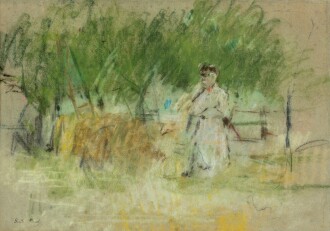Works by Berthe Morisot at Sotheby's
Berthe Morisot Biography
Born in Bourges, France on January 14, 1841 to an upper middle-class family, Berthe Morisot was a French painter who would become an integral part of the Impressionist circle. Granddaughter of the prolific Rococo painter Jean-Honoré Fragonard, Morisot decided to pursue a career as an artist and began training under well-respected artists such as Joseph Guichard and Camille Corot.
In 1864, at the age of twenty-three, Morisot exhibited her work for the first time at the Salon de Paris and would continue to participate in the Salon until 1868, receiving encouraging reviews. By 1868, fellow artist Henri Fantin-Latour introduced Morisot to Édouard Manet, and the two became close friends. They would continue to mutually advise and support each other throughout their careers, and in 1874 Morisot married Manet’s brother, Eugène.
Morisot was an integral member of the artists who founded the Impressionist exhibitions in the 1870’s and in 1874, Morisot resolutely abandoned Salon exhibitions, exclusively showing her works in the Impressionist exhibitions of the 1870’s and 1880’s. Commercially, her work was managed by the dealer Paul Durand-Ruel, and although she never achieved financial independence with her artwork, she outsold Claude Monet, Pierre-Auguste Renoir, and Alfred Sisley in a March 1875 auction at Hôtel Drouot.
Like her female contemporaries Mary Cassatt and Eva Gonzalès, Morisot was prohibited from the majority of public spaces and was confined to the sites prescribed by her class and gender. For this reason, most subjects of Morisot’s paintings were members of her family in domestic settings. Her deft use of luminous color and the hurried quality of her brushstrokes reveal an instinctive sensibility to the principles that defined the Impressionist movement, and garnered positive reviews from critics such as Paul Mantz and Théodore Duret, as well as the respect and admiration of her contemporaries.
Read Less











